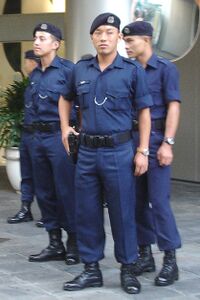Durkha: Difference between revisions
Lyooonheimer (talk | contribs) No edit summary |
Lyooonheimer (talk | contribs) No edit summary |
||
| Line 18: | Line 18: | ||
After the collapse of the Khaddic Empire, the Durkhas existed in peace as the Mahanan government specifically passed a law to allow their work to continue, legally, as long as they could show proof of their allegiance to the Durkhas with their blade. | After the collapse of the Khaddic Empire, the Durkhas existed in peace as the Mahanan government specifically passed a law to allow their work to continue, legally, as long as they could show proof of their allegiance to the Durkhas with their blade. | ||
They spent a majority of this time working for free as warrior monks, protecting the Gai. | |||
===Official Foundation=== | ===Official Foundation=== | ||
===Mahanan-Mekabirian War=== | ===Mahanan-Mekabirian War=== | ||
Revision as of 11:17, 25 February 2022
The Durkhas or Dorkhas (Mahanan: गोर्खा | Gōrkhā-), are soldiers native to Mahana renowned for their fighting prowess.
The Durkha units are composed of Mahanans and are recruited for several militaries around the world; The Mahanan Military, the Mekabirian army, the Namdatkan army and X army as well as being deployed for AN peacekeeping forces and in warzones around the wurld.
Origins
Historically, the term 'Durkha' and 'Dorkha' originate from the western regions of Mahana from the Khaddic Empire were the family of 'Durkarie' were hugely important advisors to the emperor. The Durkhas were initially a group of highly skilled and practised mercenaries and warrior monks that were hired by the Durkarie to protect them, giving them the name the 'Durkhas' or 'Dorkhas'. The name itself means ('Holy Protectors' or 'Pavitra Durkhā')
The Durkha military units are deployed around the world, notably in the Mekabirian amry, the Mahanan army itself and the Namdatkan army. They are also deployed as part of the AN peacekeeping forces.
The Durkha military are always associated with their important 'Kuhkiri', a traditional forward curving Mahanan blade. When describing the Durkha, Namdatkan Army Chief of Staff Field Marshall Palmo Jigme stated; "If a man says he is not afraid of dying, he is either lying or he is a Durkha."
Background
Earliest Forms
The earliest forms of the Durkha date back to the early Khaddic Empire were those who eventually came to be known as the Durkhas were a small, skilled and well known regional mercenary group for hire. They followed the principles of Gaism, however, which has remained a commonality in the regiments of Durkhas even until present day.
Before their official foundation, they are most well known for being hired by the emperor of the Khaddic Empire to protect the empire's top advisors and generals as well as the emperor himself. They got the earliest version of their name as a group when hired to defend the 'Durkarie' family of advisors, which is when they first became known as the 'Durkhas'.
After the collapse of the Khaddic Empire, the Durkhas existed in peace as the Mahanan government specifically passed a law to allow their work to continue, legally, as long as they could show proof of their allegiance to the Durkhas with their blade.
They spent a majority of this time working for free as warrior monks, protecting the Gai.
